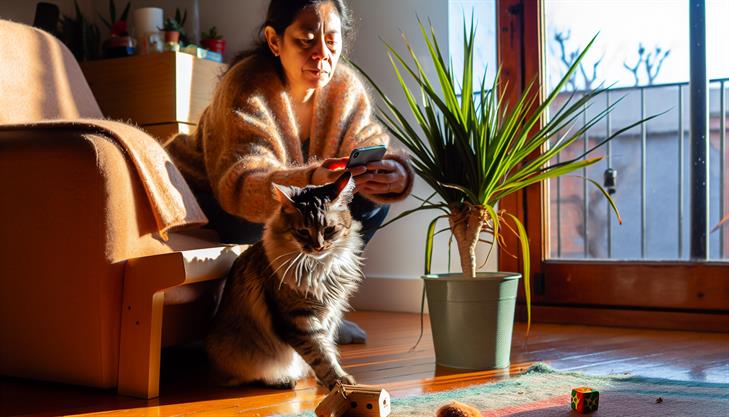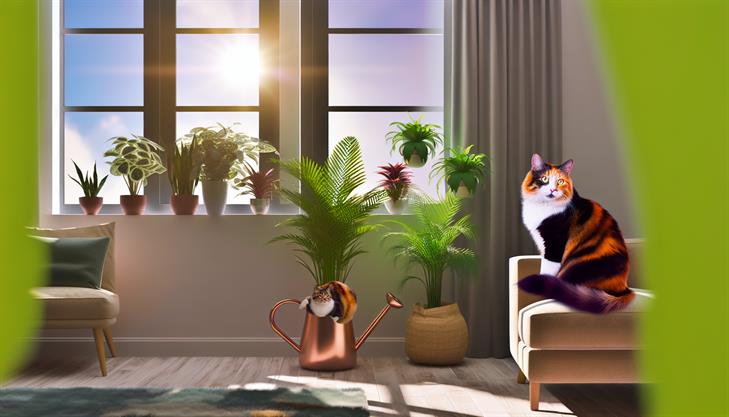Picture this: you’ve just added a lush dracaena plant to your home, its vibrant green leaves lending a fresh, natural vibe to your living space. But as you admire your new botanical addition, your beloved feline friend saunters over, eyes glinting with curiosity. Before you know it, those green leaves have become the latest object of your cat’s attention. Suddenly, a niggling question arises: Are dracaena plants safe for cats?
This question is not just a fleeting thought for countless pet owners; it’s a crucial concern that blends the art of home decorating with the responsibility of pet ownership. Considering that over 25% of American households boast both cats and plants, the intersection of these worlds leads to important safety considerations. Understanding the risks associated with keeping plants in proximity to your pets can mean the difference between a harmonious coexistence and an emergency vet visit.
In this guide, we delve into the specifics of dracaena plants and their potential effects on cats, helping you navigate your way to a pet-friendly home decor strategy. We’ll explore expert insights and offer practical tips to ensure that your home remains a safe haven for both the vibrant greenery you love and the furry companions you adore. Let’s make sure those purrs stay worry-free as you cultivate your indoor garden paradise.
Understanding Dracaena Plant Toxicity: What Makes Them Harmful to Cats
Dracaena plants are a popular choice for indoor greenery due to their striking appearance and relatively easy care. However, cat owners often find themselves asking, "Are Dracaena plants poisonous to cats?" Unfortunately, the answer is yes. Understanding the toxicity of Dracaena to cats can help you make informed decisions to ensure your feline friend’s safety while enjoying the benefits of indoor plants.
Why Are Dracaena Plants Harmful to Cats?
Dracaena plants contain saponins, a naturally occurring compound that is toxic to cats. When ingested, these substances can cause a range of symptoms, from mild to severe, depending on the amount consumed and the individual cat’s sensitivity. Common issues arising from Dracaena toxicity include vomiting, diarrhea, loss of appetite, and sometimes even depression in cats due to the discomfort and distress it causes.
Symptoms of Dracaena Poisoning in Cats
If you suspect your cat has nibbled on a Dracaena plant, watch out for these symptoms:
- Vomiting and Diarrhea: These are typical signs of plant poisoning.
- Loss of Appetite: Your cat may avoid food due to an upset stomach.
- Increased Drooling: This can occur as the cat’s body responds to the toxin.
- Lethargy or Weakness: A common reaction to internal distress.
- Dilated Pupils: May occur in some cases due to the effects of the saponins.
It’s important to note that while Dracaena plants are harmful to cats, they are not usually fatal. However, severe cases may require veterinary attention to alleviate symptoms and prevent dehydration from vomiting or diarrhea.
Preventing Cat Poisoning From Dracaena
1. Placement and Accessibility:
- Elevate Plants: Place Dracaena plants out of reach of your cat. Consider high shelves or hanging planters.
- Closed Rooms: Keep Dracaena in rooms your cat cannot access, if feasible.
2. Distraction and Alternatives:
- Cat Grass: Offer your cat cat-safe plants like cat grass to chew on as an alternative.
- Toys and Enrichment: Keep your cat busy with toys to reduce plant-chewing out of boredom.
3. Training and Deterrents:
- Use Deterrent Sprays: Non-toxic cat deterrent sprays can make the plant unappealing.
- Positive Reinforcement: Train your cat to avoid off-limits areas using positive strategies and treats.
Additional Advice for Cat Owners
If you have Dracaena plants and are concerned about your cat’s curiosity, it might be wise to opt for non-toxic plants instead. Pet-friendly plants such as spider plants, areca palms, and bamboo are safer alternatives.
If your cat does happen to ingest Dracaena, contact your veterinarian immediately for advice and potential treatment. Prompt action can help minimize the impact of the toxins and ensure your cat’s health and well-being.
Through awareness and preventive measures, it is entirely possible to create a harmonious environment that honors both your love for plants and the safety of your beloved feline companions.
Signs and Symptoms of Dracaena Poisoning in Cats
Dracaena plants, popular for their lush foliage and air-purifying qualities, are often a choice for houseplant enthusiasts. However, cat owners should be aware that dracaena plants are toxic to cats. When ingested, they can cause various health issues in felines. If you’re wondering "are dracaena plants poisonous to cats," the short answer is yes. Here’s a comprehensive guide to understanding this toxicity and ensuring your cat’s safety.
Understanding Dracaena Toxicity
Dracaena plants contain saponins, chemical compounds found naturally in several plant species. While these substances are harmless to humans, they can be toxic to cats and dogs. When a cat chews on dracaena leaves or stems, it ingests these saponins, leading to potential health problems.
Recognizing the Signs and Symptoms
If your cat has nibbled on a dracaena plant, watch out for the following signs and symptoms:
- Vomiting: This is one of the most common symptoms. It may begin almost immediately or within hours of ingestion.
- Loss of Appetite: Cats may lose interest in food, leading to decreased nourishment.
- Excessive Drooling: An affected cat might drool more than usual due to mouth irritation.
- Lethargy: Your cat may become unusually tired, sleeping more or showing a lack of energy.
- Dilated Pupils: Changes in the size of your cat’s pupils can indicate stress or poisoning.
- Coordination Issues: Ataxia or wobbliness may occur if the nervous system is affected.
Steps to Take if Your Cat Ingests Dracaena
If you suspect your cat has chewed on a dracaena plant, follow these steps promptly:
- Remove Access: Immediately relocate the plant to prevent further ingestion.
- Observe: Closely monitor your cat’s behavior for any of the signs mentioned above.
- Call Your Veterinarian: Seek professional advice quickly to understand the next steps. In some cases, your vet may recommend an immediate visit.
- Bring a Sample: If possible, take a small part of the plant with you to help your vet confirm the species and decide on the best treatment.
- Follow Veterinary Instructions: Treatment may involve inducing vomiting, administering activated charcoal, or providing fluids to prevent dehydration. Follow your vet’s instructions closely.
Preventive Measures
To protect your feline companion, consider these preventive strategies:
- Choose Non-Toxic Plants: Opt for cat-friendly houseplants like spider plants, Boston ferns, or bamboo palm instead.
- Create Separate Spaces: If having dracaena is essential, place them in areas inaccessible to your cat, such as on high shelves or in rooms your cat cannot enter.
- Use Deterrents: Employ pet-safe repellents or bitter sprays to discourage your cat from chewing on plants.
Final Advice
Understanding whether "are dracaena plants poisonous to cats" is crucial for ensuring a safe environment for your pet. Always choose houseplants carefully and be vigilant about monitoring your cat’s health and environment. If you suspect any poisoning, quick action is essential. Remember, when it comes to the well-being of our furry friends, prevention is always better than cure.
Immediate Steps to Take If Your Cat Ingests Dracaena
Understanding whether dracaena plants are poisonous to cats is crucial for any pet owner who values both their beloved pet and household greenery. Dracaena, characterized by its striking foliage, can indeed pose a risk to your feline friend. These popular ornamental plants contain saponins—a chemical compound that can cause adverse reactions in cats if ingested.
Signs of Dracaena Toxicity in Cats
When a cat consumes part of a dracaena plant, they might exhibit several symptoms as the toxicity takes effect. These symptoms commonly include:
- Vomiting, sometimes with traces of blood.
- Excessive drooling.
- Loss of appetite.
- Lethargy or weakness.
- Dilated pupils.
- Increased heart rate.
Recognizing these symptoms early can prompt immediate action, which may significantly mitigate health issues related to the ingestion of dracaena.
Immediate Steps to Take
If you suspect that your cat has ingested any part of a dracaena plant, follow these steps without delay:
-
Assess the Situation: Carefully observe your cat for any signs of distress or unusual behavior. Monitor for symptoms such as vomiting, drooling, or loss of appetite.
-
Limit Further Access: Ensure that your cat can no longer reach the dracaena plant. This might involve moving the plant to a different location or temporarily securing your cat in a safe area.
-
Contact Your Veterinarian: Reach out to a veterinarian as soon as possible. Provide details about the incident, including the amount ingested and any symptoms noted. They might instruct you to bring your cat in for an examination or advise on at-home care steps.
-
Induce Vomiting (Only If Advised): Sometimes, a vet may recommend inducing vomiting to prevent further absorption of the toxins. This step should only be performed under professional guidance.
-
Provide Hydration: Encourage your cat to drink water. Hydration is essential for flushing toxins from their system and preventing dehydration, especially if vomiting has occurred.
-
Follow Up: Even if symptoms subside, a follow-up visit to the vet can ensure no internal damage has occurred. Your cat’s recovery will depend on how quickly and effectively the situation was managed.
Prevention and Additional Tips
-
Remove Dracaena from Homes with Cats: The simplest way to prevent poisoning is to eliminate dracaena plants from your home. Consider replacing them with cat-safe plants like spider plants or bamboo.
-
Educate Household Members: Make sure everyone in the household is aware of the potential danger these plants pose to cats. Young children, in particular, should be taught not to give plants to pets.
-
Regularly Check Plant Health: Pets are often more attracted to plants that appear distressed or shedding. Keeping plants healthy can reduce the likelihood of your cat being attracted to them.
-
Create Cat-Safe Zones: For homes with multiple plants, designate specific areas as safe zones for your cat, ensuring no toxic plants are within their reach.
By taking these precautions and knowing the immediate steps to take, pet owners can significantly reduce the risk of dracaena toxicity in cats, ensuring a safer environment for their furry companions.
Safer Alternatives to Dracaena Plants for Cat Owners
Dracaena plants, with their striking foliage and easy maintenance, are popular choices for houseplant enthusiasts. However, many pet owners frequently wonder, "Are Dracaena plants poisonous to cats?" The straightforward answer is yes; Dracaena plants can indeed be toxic to our feline friends. Understanding this risk is essential for cat owners who wish to maintain a pet-friendly environment while enjoying indoor greenery.
Why Dracaena Plants Are Poisonous to Cats
Dracaena plants contain saponins, a group of naturally occurring chemicals that can be harmful to cats if ingested. These compounds are used by the plant as a natural defense mechanism to deter herbivores. When cats consume any part of the Dracaena plant, they may experience adverse reactions due to these saponins.
Symptoms of Dracaena Plant Poisoning in Cats
It’s important to recognize the signs of Dracaena poisoning, as timely intervention can prevent more serious complications. Common symptoms include:
- Vomiting and Nausea: Cats may exhibit repeated vomiting, often accompanied by a lack of appetite.
- Excessive Drooling: Over-salivation is a frequent response to the ingestion of toxic plant materials.
- Lethargy: Affected cats might exhibit unusual drowsiness or general fatigue.
- Loss of Appetite: A sudden lack of interest in food is often noted, indicating gastrointestinal distress.
- Dilated Pupils: Observing changes in your cat’s eye appearance can signal a toxic response.
What to Do if Your Cat Eats a Dracaena Plant
If you suspect your cat has ingested part of a Dracaena plant, it’s essential to act quickly:
- Remove Access: Immediately remove the plant or relocate your cat to prevent further ingestion.
- Assess Symptoms: Monitor your cat for any of the symptoms listed above. Severity can vary, but early detection is critical.
- Contact Your Veterinarian: Reach out to your vet or an animal poison control hotline for guidance. They can provide specific instructions on what to do next, which might include bringing your cat in for an examination.
- Follow Medical Advice: Depending on the severity of the symptoms, your vet may advise supportive care at home or recommend further medical treatment.
Safer Plant Alternatives for Cat Owners
Fortunately, cat owners don’t need to forego indoor plants altogether. There are numerous non-toxic plant options that can beautify your space without posing a risk to your furry companions:
- Spider Plants: These plants are pet-safe and easy to care for, making them a great choice for any household.
- Boston Ferns: Known for their lush fronds, they are safe for cats and add a classic touch to any room.
- Bamboo Palm: Adding elegance and a tropical feel, this plant is non-toxic to cats.
- Areca Palm: Similar to the bamboo palm, this plant offers a pet-friendly option with managed care needs.
Preventive Tips for Cat Owners
To ensure your home remains a safe haven for your cat:
- Research Before Buying: Always verify the safety of a plant before bringing it into your home.
- High Placement: If you currently own Dracaena plants and can’t immediately replace them, place them on high shelves or hang them from the ceiling where cats can’t reach.
- Create Distractions: Provide plenty of cat-safe toys and climbing structures to deter curiosity about your plants.
By choosing safe plant alternatives and being vigilant about potential hazards, cat owners can enjoy the beauty of indoor plants without compromising the well-being of their pets.
Preventing Accidental Ingestion: Tips to Keep Your Cats Safe
Dracaena plants are a popular choice for indoor greenery due to their striking foliage and easy-care nature. However, if you’re a cat owner, it’s important to know that dracaena plants can be toxic to cats. Understanding the risks and taking steps to prevent accidental ingestion is crucial for keeping your feline friends safe.
Toxicity of Dracaena Plants
Dracaena plants contain saponins, organic compounds that are harmless to humans but can cause adverse reactions in cats. These compounds can lead to symptoms such as vomiting, loss of appetite, drooling, and lethargy when ingested by your cat. In some cases, there can also be a noticeable increase in your cat’s thirst, diarrhea, and coordination issues.
Steps to Prevent Accidental Ingestion
-
Placement: The simplest way to prevent your cat from chewing on dracaena is to keep these plants out of reach. Place them on high shelves, hang them from the ceiling, or position them in rooms that your cat does not frequent.
-
Deterrents: Use pet-safe deterrent sprays on the plants. These sprays create an unpleasant taste that can discourage cats from nibbling. However, ensure that the sprays are non-toxic and safe for both pets and plants.
-
Alternative Plants: Consider replacing dracaena plants with non-toxic alternatives if possible. Plants like spider plants or palms are visually appealing and pose no known threat to pets.
-
Training: While it might be challenging, training your cat to avoid certain areas can be effective. Use positive reinforcement when your cat shows interest in areas without plants.
-
Cat Grass: Providing cat grass (like wheatgrass) can satisfy your cat’s urge to chew, thereby distracting them from houseplants like dracaena.
Additional Safety Tips
-
Regular Monitoring: Keep a close watch on your cat’s behavior around plants. If you notice any signs of poisoning, remove the plant from the environment immediately and seek veterinary care if necessary.
-
Routine Checks: Regularly inspect your plants for signs of chewing or damage. This can give you an early indication if your cat is attempting to eat them despite your preventive measures.
-
Consult Your Vet: If you’re unsure about the safety of any plant in your home, consult with your veterinarian. They can provide guidance on what plants to avoid and steps to take in case of accidental ingestion.
By taking these preventive measures and being informed about the potential dangers of dracaena plants, you can create a safer environment for your cats while still enjoying the beauty of indoor greenery.
In conclusion, while dracaena plants are a popular choice for indoor greenery due to their aesthetic appeal and low maintenance requirements, they do pose a risk to our feline friends. As highlighted, the ingestion of dracaena leaves can lead to mild to moderate symptoms in cats, such as vomiting, loss of appetite, and lethargy. It is crucial for pet owners to be aware of these potential hazards and take preventive measures to ensure their homes are safe and cat-friendly.
If you currently own a dracaena plant and share your space with a cat, it may be wise to place the plant in an area that is out of reach or consider switching to non-toxic alternatives, such as spider plants or Boston ferns, which are equally beautiful and safe for pets.
A final tip to consider is keeping a pet first-aid kit on hand and being familiar with emergency vet contact information. This preparedness ensures you can swiftly act in case of any accidental ingestion, providing peace of mind while you create a harmonious home environment for both your plants and your pets.


